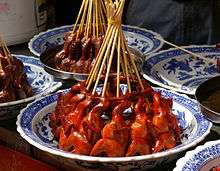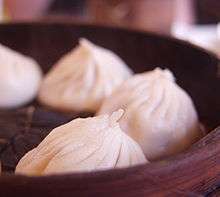Shanghai cuisine
Shanghai cuisine (Chinese: 上海菜; pinyin: Shànghǎi cài), also known as Hu cuisine (simplified Chinese: 沪菜; traditional Chinese: 滬菜; pinyin: Hù cài), is a popular style of Chinese food. In a narrow sense, Shanghai cuisine refers only to what is traditionally called Benbang cuisine (本帮菜; 本幫菜; Běnbāng cài; 'local cuisine') which originated in Shanghai; in a broad sense, it refers to complex and developed styles of cooking under profound influence of those of the surrounding provinces, Jiangsu and Zhejiang. It takes "colour, aroma and taste" as its elements, like other Chinese regional cuisines, and emphasises in particular the use of seasonings, the quality of raw ingredients and original flavours. Shanghai was formerly a part of Jiangsu province; as such Shanghai cuisine is most similar to Jiangsu cuisine and may still be classified as a part of Jiangsu cuisine. Although it has come into more contact with Zhejiang cuisine and foreign influences as an international city. The adoption of Western influence in Shanghai cuisine developed a unique cooking style known as Haipai cuisine.
 |
| Chinese cuisine |
|---|
|
|
Overseas cuisine |
|
Ingredients and types of food |
|
| Shanghai cuisine | |||||||||||
|---|---|---|---|---|---|---|---|---|---|---|---|
| Chinese | 上海菜 | ||||||||||
| |||||||||||
| Hu cuisine | |||||||||||
| Simplified Chinese | 沪菜 | ||||||||||
| Traditional Chinese | 滬菜 | ||||||||||
| |||||||||||

Characteristic
Shanghai dishes usually appear red and shiny because they are often pickled in wine. They are cooked using a variety of methods including baking, stewing, braising, steaming and deep-frying. Fish, crab and chicken are made "drunken" with spirits and briskly cooked, steamed or served raw. Salted meats and preserved vegetables are also commonly used to enhance various dishes. Sugar is an important ingredient in Shanghai cuisine, especially when used in combination with soy sauce. Another characteristic is the use of a great variety of seafood. Rice is more commonly served than noodles or other wheat products.
Shanghai cuisine emphasises the use of condiments while retaining the original flavours of raw ingredients. It aims at lightness in flavour and is mellower and slightly sweet in taste compared to some other Chinese cuisines. Sweet and sour is a typical Shanghai taste. An attractive presentation is also important in Shanghai cooking with ingredients being carefully cut and presented with a view to harmonising colours.
Although Shanghai is a sea port, most families did not incorporate fish in their daily meals in the early 20th century. Eating meat with meals was considered a luxury, as the typical meal consisted of vegetables, beans, and rice. In a month, most families typically usually ate meat or fish for about four meals: on the second, eighth, sixteenth, and twenty-third day of each month. These days became known as dang hun.[1] In recent times, special attention has been paid to low-sugar and low-fat food, with a good quantity of vegetables and improved nutritional value.
History
Shanghai cuisine is the youngest among the ten major cuisines of China although it has a history of more than 400 years. Traditionally called Benbang cuisine, it originated in the Ming and Qing dynasties (c. 1368-1840). In the later part of the 19th century, after Shanghai became a major domestic and international trading port, Benbang dishes underwent some substantial changes, adopting influences from other cuisines which added to its complexity.
Notable dishes in Shanghai cuisine
Seafood
.jpg)
- Eel noodles – (鳗鱼面; 鰻魚麵; Mányú Miàn) – Made with sliced eels and wheat noodles.[2]
- Scallion stewed crucian carp – (葱烧鲫鱼; 蔥燒鯽魚; Cōngshāo Jìyú) – This is rather involved and complex preparation for the common crucian carp. The dish requires long hours for preparation since the fish needs to be soaked in vinegar, and then deep-fried, stewed for a long prolonged period, and cooled to make the fish tender enough to consume together with all its bones. Due to the complexity of its preparation and the difficulty in perfecting it, the dish was sometimes used by families as a test when recruiting a cook.[3]
- Shanghai hairy crab (上海毛蟹; Shànghǎi Máo Xiè) – A variety of Chinese mitten crab. The crab is usually steamed with fragrant ginger, and consumed with a dipping sauce of rice vinegar, sugar and ginger. Mixing crabmeat with lard to make Xiefen, and consuming it in xiaolongbao or with tofu is another highlight of hairy crab season.[4][5]
- Squirrel-shaped mandarin fish (松鼠桂鱼; 松鼠桂魚; Sōngshǔ Guīyú) – This dish uses fresh mandarin fish. The fish is deep-fried and has a crispy exterior and soft interior. Yellow and red in colour, it is displayed in the shape of a squirrel on the plate. Hot broth is poured over, which produces a high-pitched sound. Sour and sweet flavours are combined in this dish.[6]
Meat and poultry
- Beggar's chicken (叫化鸡; 叫化雞; Jiàohuā Jī) – Beggar's Chicken calls for a chicken wrapped in lotus leaves, encased in mud, and roasted in fire, resulting in a delicious and tender meat. According to a legend, a beggar in the Qing dynasty stole and hid a chicken under mud.[2]
- Lion's head (狮子头; 獅子頭; Shīzi Tóu) – The name derives from the shape of the pork meatball which is supposed to resemble a lion's head and the cabbage (or other vegetables), which is supposed to resemble the lion's mane. It is served in two varieties: the white (or plain), and the red (cooked with soy sauce), and is usually in a white pot.[2]
- Red braised pork belly (红烧肉; 紅燒肉; Hóngshāo Ròu) – The dish is a braised pork belly cooked in Shanghainese soy sauce for a long time, resulting in a juicy and tender meat.[2]
- Sweet and sour spare ribs (糖醋排骨; Táng Cù Páigǔ) – The fresh pork ribs, which appear shiny and red after being cooked, are traditionally deep fried then coated in a sweet and sour sauce.[7]
Snacks

- Shengjian mantou (生煎馒头; 生煎饅頭; Shēngjiān Mántóu) or Shengjianbao (生煎包; Shēngjiān bāo) – It is typically in a round bun, similar yet thicker than a xiaolongbao (due to the addition of yeast) and is stuffed with pork. It is then pan-fried and seasoned with sesame seeds and chopped scallions.[8]
- Xiaolongbao (小笼包; 小籠包; Xiǎolóngbāo) – A type of steamed bun made with a thin skin of dough and stuffed with pork or minced crabmeat, and soup. The delicious soup inside can be hold up until it is bitten.[9]
Desserts
References
- Hanchao Lu (1999). Beyond the Neon Lights: Everyday Shanghai in the Early Twentieth Century. University of California Press. ISBN 0520215648.
- Deason, Rachel. "Traditional Shanghainese Dishes You Must Try". Culture Trip. Retrieved 2019-12-15.
- Lee, Jesse (2008), 上海味兒, 旗林文化, ISBN 978-986-6655-14-2
- "The That's Guide to Gorging on Shanghai Hairy Crab". www.thatsmags.com. Archived from the original on 11 April 2019. Retrieved 10 August 2019.
- "Zoobenthos Archived 2015-01-09 at the Wayback Machine". The Shanghai Jiuduansha Wetland Nature Reserve (Shanghai), 2014.
- 名家名菜—松鼠鳜鱼. home.meishichina.com. Archived from the original on 28 August 2019. Retrieved 28 August 2019.
- 上海糖醋小排. www.meishij.net. Archived from the original on 29 August 2019. Retrieved 29 August 2019.
- Wei, Clarissa (2017-04-27). "A Guide to 14 of the Most Iconic Foods in Shanghai". Vice. Retrieved 2019-12-15.
- 各地特色小笼包介绍,看完对它有不一样的情感!. kknews.cc. Retrieved 29 August 2019.
External links
| Wikimedia Commons has media related to Cuisine of Shanghai. |
- china.org.cn Top 10 most famous Shanghai snacks September 12, 2011